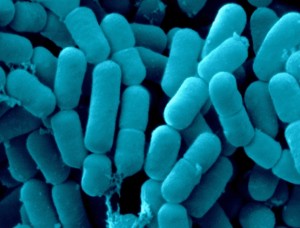Jan 22 2015
Fail Safe for Artificial Life
 In Jurassic Park the scientists who created the dinosaurs from DNA trapped in amber included what they called the “lysine contingency.” They engineered the dinosaurs so that they could not manufacture the amino acid lycine. The dinosaurs could only survive if they were fed lysine by the park staff. Without the supplement they would quickly fall into a coma and then die.
In Jurassic Park the scientists who created the dinosaurs from DNA trapped in amber included what they called the “lysine contingency.” They engineered the dinosaurs so that they could not manufacture the amino acid lycine. The dinosaurs could only survive if they were fed lysine by the park staff. Without the supplement they would quickly fall into a coma and then die.
This contingency was a fail safe if any dinosaur ever escaped from their designated areas, or from the park itself. However, the lysine contingency failed. Dinosaurs could survive by eating lysine rich foods, like chickens or soya beans, or other dinosaurs.
Biologists have now done Jurassic Park one better. Genetically modified bacteria are extremely useful. Bacteria have been engineered to produce drugs, like insulin, or to eat up spilled toxins or petroleum products, or to make synthetic fuel. There is always a concern, however, that such a synthetic bacteria could get out into the wild with unpredictable effects. Physical containment strategies are therefore used to minimize the chance of this happening.
Research teams at Harvard and Yale have developed a new strategy of containment. The genetic code shared by all life involves a language of 3 nucleotides, of which there are 4 types, resulting in 64 different combinations. Each three letter combination codes for an amino acid, of which there are 20 used by living organisms. This allows for some redundancy, with each amino acid having 2-3 different codes. There are also some regulatory codes, such as stop codons – three letter combinations that tell the machinery to stop making the protein at that point.
What the researchers did was to coopt a stop codon and reprogram the machinery so that instead that 3-letter code would result in the incorporation into the protein of an artificial amino acid. This amino acid does not exist in nature, it has to be cooked up in the lab.
This strategy provides a double fail safe. The bacteria are now dependent upon an amino acid that they cannot find out in the wild, it has to be fed to them in the lab, because it is artificial. Further, the genetic code of these bacteria have been changed. They no longer share that code with the rest of life on earth, they are truly synthetic organisms. This makes them resistant to certain viruses.
The researchers hope to build on this success to engineer bacteria with multiple overlapping fail safes. In addition to making them dependent on artificial amino acids, genetic tweaks can also make them dependent on certain chemicals. Also, as the researchers coopt additional codons, the resulting bacteria will become more and more different from other life, making them resistant to a greater range of viruses.
The result would be strains of bacteria that could not possibly survive in the wild, could not share their genetic material with other bacteria, and are not vulnerable to viruses. Once our experience with such bacteria is extensive enough that we have a high degree of confidence the containment strategies will work, we may become confident enough to deploy such bacteria in living organisms, even people.
This is an important milestone in the development of artificial life. Already they have proven extremely useful, making it possible, for example, to mass produce insulin. The possible applications are now dramatically increased.
In Jurassic Park the point was made that “life finds a way.” We can try to contain it, but it wants to get out, and of course it does. This is a valid concern. Billions of replicating bacteria provide many opportunities to explore the entire space of possible solutions through random mutations.
That is why I agree that having multiple fail safes in the same bacterium is a great idea. We may never reduce the probability of the fail safes failing to zero, but we can reduce the probability to such an extent that it will take billions of years on average for random mutations to find a work around. Obviously we will need extensive safety studies to confirm that the probability is really that low.
So far experiments involving 100 billion cells for up to 20 days have not resulted in any bacteria evolving around the single fail safe. This is reassuring, but we will need much more data than that to quell fears of releasing synthetic bacteria into the wild with only these physiological containments. It seems likely that we will get there.
It is possible that synthetic biology will be one of the dominant technologies of the 21st century. We’ll only know once we can look back, but it certainly seems promising.






